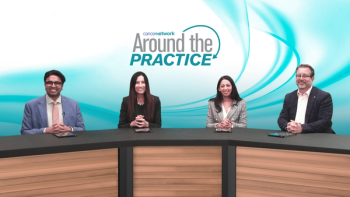Articles by Mansi Shah, MD

Panelists discuss how the treatment landscape for patients with transplant-ineligible/deferred newly diagnosed multiple myeloma (NDMM) is expected to evolve, with considerations for optimizing therapeutic approaches based on emerging data from novel drug combinations and treatment strategies.

Panelists discuss how frailty assessment influences treatment decisions in patients with transplant-ineligible newly diagnosed multiple myeloma (NDMM), particularly examining the IFM2017-03 study’s evaluation of a dexamethasone-sparing approach using daratumumab plus lenalidomide in frail patients.

Panelists discuss how isatuximab- and daratumumab-based quadruplet regimens compare in patients with transplant-ineligible/deferred newly diagnosed multiple myeloma (NDMM), with a particular focus on minimal residual disease (MRD) negativity data from the IMROZ and CEPHEUS trials, presented at the 2024 American Society of Hematology (ASH) Annual Meeting and Exposition.

Panelists discuss how treatment strategies and sequencing decisions for patients with multiple myeloma who decline transplantation despite eligibility must be carefully tailored, considering both immediate therapeutic goals and potential future treatment options.

Panelists discuss how the CEPHEUS study comparing subcutaneous daratumumab plus VRd vs VRd alone in patients with transplant-ineligible newly diagnosed multiple myeloma (NDMM) provides important insights into the role of quadruplet therapy in this specific population.

Panelists discuss how the evolving treatment landscape for patients with transplant-eligible newly diagnosed multiple myeloma (NDMM) is being shaped by emerging data on optimal treatment sequencing strategies, both in frontline settings and subsequent lines of therapy.

Panelists discuss how recent findings from the GMMG-HD7 trial comparing isatuximab-RVd vs RVd have shaped treatment decision-making in patients with multiple myeloma by providing comparative efficacy and safety data between the 2 regimens.

Panelists discuss how the choice between isatuximab-based quadruplet and daratumumab-based regimens in multiple myeloma treatment depends on clinical trial data comparing Isa-KRd vs KRd, with particular emphasis on efficacy outcomes and patient-specific factors that might influence treatment selection.

Panelists discuss how the AURIGA trial demonstrates superior outcomes with daratumumab plus lenalidomide maintenance compared with lenalidomide alone after autologous stem cell transplantation (ASCT) in newly diagnosed multiple myeloma while examining key subgroup analyses that inform treatment decisions regarding posttransplant maintenance therapy selection.

Panelists discuss how while daratumumab-based quadruplet regimens are increasingly becoming the standard of care for patients with transplant-eligible newly diagnosed multiple myeloma (TE NDMM) due to superior efficacy data, certain factors like frailty, comorbidities, and cost considerations may still warrant triplet therapy in select cases.

Panelists discuss how recent pivotal trials like PERSEUS and CASSIOPEIA demonstrate superior outcomes with daratumumab-based quadruplet and triplet combinations compared with standard regimens in transplant-eligible newly diagnosed multiple myeloma patients, particularly showing improved progression-free survival when daratumumab is added to VRd (bortezomib, lenalidomide, and dexamethasone) or VTd (bortezomib, thalidomide, and dexamethasone) backbones.

Panelists discuss how the treatment paradigm for newly diagnosed multiple myeloma (NDMM) has evolved from conventional chemotherapy to modern regimens incorporating novel agents like proteasome inhibitors, immunomodulatory drugs, and monoclonal antibodies while highlighting persistent challenges including optimizing treatment sequencing and addressing high-risk disease.




